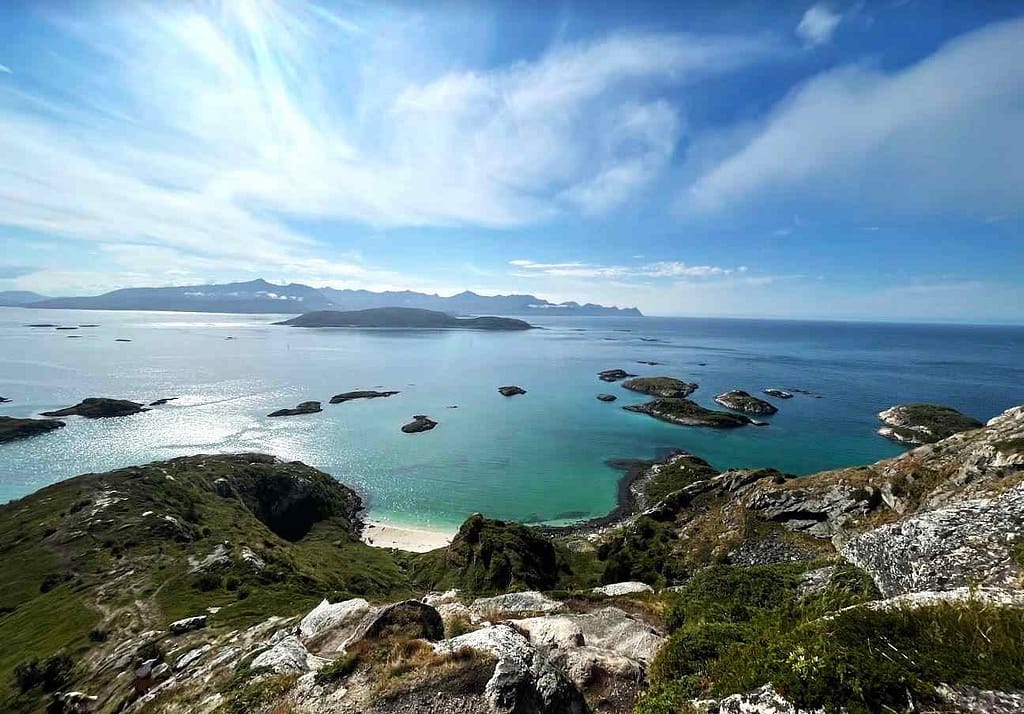– I prefer steep and fun, my wife’s good friend tells us. We have just climbed Skamtinden, one of many airy mountains in Tromsø. Steep and fun refers to skiing down Storstolpan, the mountain next to the one we climbed and part of the popular Ersfjord Traverse.
During our 5 days in Tromsø, we didn’t see one snow capped mountain. Even the highest, Tromsdalstinden (1238m) has no snow, which hasn’t happened since 1972, according to locals.
Last year was the warmest summer recorded in Tromsø. 27 days with temperatures above 20 degrees. An average summer in Tromsø has 12 days with 20 degrees or more. By August 12. this year, 32 warm days are recorded. Just to remind the reader: If you head straight west from Tromsø, you reach the center of Greenland.
Without the Gulf Stream Norway would be 10-15 degrees colder.
Which is actually something that might happen in my lifetime.
The Atlantic ocean currents may collapse in 20 years
The week before we go I read a very worrying article about the Atlantic Meridional Overturning Circulation (AMOC).
Researchers at Utrecht University is soon to publish a study suggesting that the AMOC may collapse as early as the 2030s. The AMOC is crucial to distribute heat and cold between the Northern and Southern hemisphere as well as nutrients to marine ecosystems. This circulation brings warmth to various parts of the globe and also carries nutrients necessary to sustain ocean life. It takes an estimated 1,000 years for a parcel (any given cubic meter) of water to complete its journey along the belt. 100 years after the collapse Arctic ice may extend to the southern coast of England. The Gulf Stream may no longer bring warm waters along Norway’s coast which means no more warm summers in this Caribbean Arctic.
Can’t Take My Eyes Off Of You
Two days after our climb, we decide to go to Hillesøya, a 2 square kilometer island outside of Norway’s fifth largest island Kvaløya.
One big difference between the Southern hemisphere and Northern is the crisp air. Most places with white beaches and turquoise waters has humid air, sand flies and burning sun. And not very often surrounded by steep, green mountains.
As we cross the bridge between Sommarøy and Hillesøya, there are dozens of white, small beaches located on tiny islands. They look like atolls from a distance. Going down from the top of Hillesøya (204m), heading south, our two children say “we never thought Tromsø could be like this. It’s like Bora Bora”, looking down at one of the beaches.

Travel letter from the Arctic capital
“Meet at half past one outside Scandic Ishavshotell. I’ll pick you up there.” Cool. We are going out with Arctic Princess. A 45 feet long and 8 meters wide catamaran. It’s been two years since we were out on a boat in the Arctic waters of Tromsø. Then it was the fishing boat Vulkana that has been turned into a spa and restaurant boat.
Warm, salty water
Last time I swam in Tromsø in July, water temperatures were not more than 12 degrees. We go out to the beaches we saw from the hill and put on swimwear. Jump into the water that is so clear and fresh that I want to drink it. Actually I do take a few mouth fulls just to taste it. It’s not 12 degrees. “Must be at least 17”, my wife says.

The wildfires in Australia and coral death
More than 3,000 homes are gone or damaged. 100,000 square kilometers of forests is turned to ashes. And one billion animals have lost their lives or are injured: Koalas, kangaroos, wallabies, birds and other species that only live in Australia. Climate change is singled out as the main driver for the destructive wildfires.
















